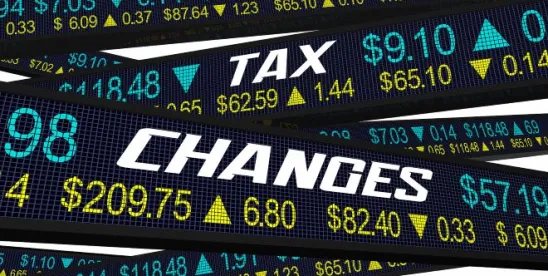The One Big Beautiful Bill Act (the “OBBBA“), passed by the U.S. House of Representatives (the “House“) on May 22, 2025, is a comprehensive legislative package that seeks to implement sweeping reforms in tax policy, immigration, healthcare, and infrastructure as part of the federal budget reconciliation process. Among other things, the OBBBA would significantly enhance the Section 199A deduction under the Internal Revenue Code (the “Code“) for individuals and other noncorporate taxpayers by extending its applicability to certain dividends issued by qualifying business development companies, or “BDCs.” Specifically, the OBBBA provides for a 23% deduction for recipients of “qualified BDC interest dividends,”[1] expanding the scope and rate of the current deduction available for qualified REIT dividends.
Key Tax Benefit
The OBBBA, as passed by the House, provides for a 23% deduction under Section 199A of the Code for individuals and other noncorporate taxpayers (e.g., trusts and estates) that receive qualified BDC interest dividends (the “Proposed Deduction“). A qualified BDC interest dividend is any dividend from an electing BDC[2] received during the taxable year that is attributable to net interest income of the BDC that is properly allocable to a “qualified trade or business” of the BDC. Given that most existing BDCs tend to engage in loan origination activities, we believe that investors in many existing BDCs could potentially benefit from the Proposed Deduction, assuming that it remains included in the final version of the OBBBA that becomes law.
In particular, the Proposed Deduction would effectively reduce the 37% highest marginal rate (40.8% taking into account the net investment income tax) to 28.49% (32.29% taking into account the net investment income tax), a reduction of 8.51%. The 8.51% reduction corresponds to an increase of 14.375% in the after-tax yield, potentially enhancing the attractiveness of BDC investments for taxable investors compared to other loan fund structures, including both private funds and registered closed-end funds, such as interval funds.
Currently, the Section 199A deduction is only 20% and is available exclusively for “qualified REIT dividends,” thus excluding BDCs from its coverage.
Pass-through Eligibility
The Proposed Deduction would be pass-through eligible, meaning that partners in a partnership that in turn owns an electing BDC may claim the Proposed Deduction on their share of qualified BDC interest dividends. Therefore, the general partner that receives carry from a partnership that owns a BDC could also benefit from the Proposed Deduction, as could investors in a private feeder fund or fund of funds that in turn invests in a BDC.
Potential Implications
The Proposed Deduction, as presently included in the OBBBA, would significantly enhance the potential after-tax returns for individual and noncorporate investors, potentially making BDCs a more attractive vehicle for income-focused portfolios. To the extent the Proposed Deduction remains included in the final version of the OBBBA that becomes law, we would expect a renewed focus on BDCs, including private BDCs, to maximize the tax efficiencies that could be gained by taking advantage of the Proposed Deduction. To that end, asset management platforms with existing BDCs may wish to evaluate the positive benefits of the Proposed Deduction on their existing BDC vehicles. Similarly, asset managers with registered closed-end funds that invest in credit instruments may want to explore the viability and potential benefits of conversion to a BDC structure, to the extent the nature and type of underlying investments would fit within the requirements for the Proposed Deduction. In addition, going forward, private credit managers may want to consider the viability and benefits of incorporating a BDC within future private credit fund structures as a means of maximizing tax efficiencies for certain types of investors. Finally, feeder funds and fund of funds that invest in BDCs should assess how the deduction can be passed through to partners and investors, including general partners receiving carried interest.
OBBBA Status
While the OBBBA has passed in the House, a corresponding version remains under discussion in the U.S. Senate (the “Senate“), and the final version of the Senate bill, including whether it will contain the Proposed Deduction, currently remains uncertain. Once the Senate has approved its own version of the OBBBA, the bill will be subject to the Congressional reconciliation process, where further revisions could be made to the OBBBA before it ultimately is approved in final form by both the House and Senate and is signed into law by the President. While there is significant pressure on the Senate to pass its own version of the OBBBA, if the Proposed Deduction is omitted from the Senate version, it is less likely to be included in the final version of the OBBBA given the necessary reconciliation process between the House and Senate versions of the OBBBA. Conversely, if it remains in the version of the bill that ultimately passes the Senate, there is a greater likelihood of the Proposed Deduction surviving and becoming part of the final version of the OBBBA. In either case, the omnibus nature of the OBBBA and the number of topics it attempts to address necessarily make any predictions on its timing, including whether or even if a final version will pass, challenging.
Takeaways
- The OBBBA, if passed into law in its current form, would increase the Section 199A deduction from 20% to 23% for qualifying investment income, and extend the deduction to qualified BDC interest dividends.
- For top-bracket taxpayers, the Proposed Deduction reduces the effective tax rate on qualifying BDC interest income from 40.8% to 32.29%, an 8.51% reduction.
- The tax cut translates to a 14.375% increase in after-tax yield, making BDCs more attractive to taxable investors.
- Only net interest income from a BDC’s qualified trade or business (e.g., lending) qualifies for purposes of the Proposed Deduction, meaning that direct lending BDCs will likely see a greater benefit from the Proposed Deduction.
- To qualify, the BDC must be an “electing BDC” (i.e., a BDC regulated under the Investment Company Act of 1940 that elects RIC treatment under Section 851 of the Code).
- The benefit of the Proposed Deduction can be passed through to partners in partnerships that in turn own BDCs, including general partners receiving carried interest and investors in private feeder funds and fund of funds.
- This change better aligns BDCs with REITs, which already benefit from the 199A deduction, potentially leveling the playing field for income-focused investment vehicles.
- Fund managers, tax advisors, and investors should evaluate how to structure ownership and distributions to maximize eligibility for the deduction.
Footnotes
[1] “Qualified BDC interest dividend” is any dividend from an electing business development company (“BDC“) received during the taxable year that is attributable to net interest income of the BDC that is properly allocable to a “qualified trade or business” of the BDC. Accordingly, only net interest income of a BDC qualifies for the deduction. We believe that lending is a qualified trade or business for this purpose.
[2] An “electing BDC” is a “business development company” (as defined in section 2(a) of the Investment Company Act of 1940) that has an election in effect under Section 851 of the Code to be treated as a regulated investment company (“RIC“).





 />i
/>i
